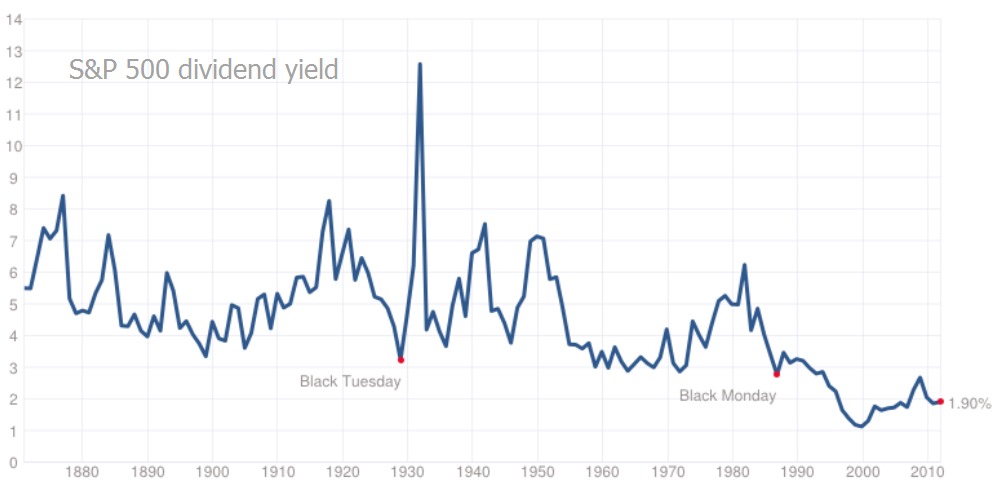By Philip Lawlor, head of Global Investment Research
Amid the relentless ascent in global equity valuations since March, none has soared as high as those of US stocks.
As shown below, the Russell 1000 multiple is up more than nine points from its March low, far outdistancing the average five-point gain for its developed peers. At a forward PE of 22.9×, the Russell 1000 is near a 15-year peak and has further widened an already huge premium to those of other developed markets, which have converged around 15-16×.
Regional 12-month forward price/earnings ratio (×)
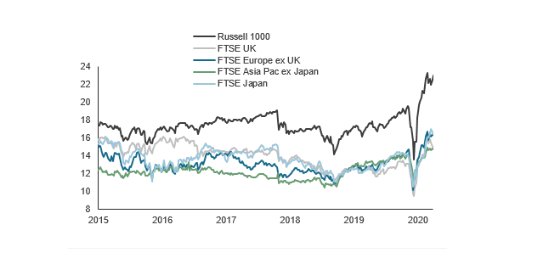
Source: FTSE Russell / Refinitiv. Data as of July 15, 2020. Past performance is no guarantee to future results. Please see the end for important disclosures.
As the chart below illustrates, multiple expansion has been the major driver of the risk rally that began in late March. It has occurred despite double-digit declines in forward EPS forecasts for most markets over the same period. Given the still-elevated uncertainties in the economic and profit outlooks, the key question now is whether this PE expansion can continue.
Total return decomposition since March 23, 2020 low (% change)
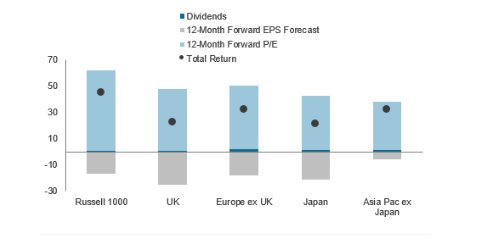
Source: FTSE Russell / Refinitiv. Data as of July 15, 2020. Past performance is no guarantee of future results. Please see the end for important legal disclosures.
Cyclically adjusted PEs (or CAPE) show an even wider rift between the US and the rest of the world. At 24×, the Russell 1000 also stands at a 15-year high (barring its February 2020 peak of 25.9×) and a large premium to developed peers, which continue to languish well below the peaks reached before the Global Financial Crisis.
Regional cyclically adjusted price/earnings (CAPE) ratios (×)
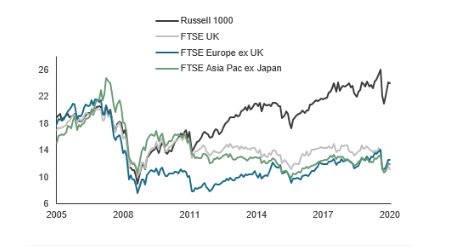
Source: FTSE Russell / Refinitiv. Data as of July 15, 2020. Past performance is no guarantee of future results. Please see the end for important legal disclosures.
While CAPE is an unreliable timing tool, there is an historically strong positive correlation between US CAPE and 10-year-forward annualized returns, as the chart below illustrates. Today’s comparatively lofty US CAPE suggests returns are likely to be lower over the next decade than during the previous 10 years. This, coupled with the stretched levels of US valuations more broadly, holds important implications for investors and asset allocators.
US CAPEs (×) versus 10-year-forward annualized real returns (%)
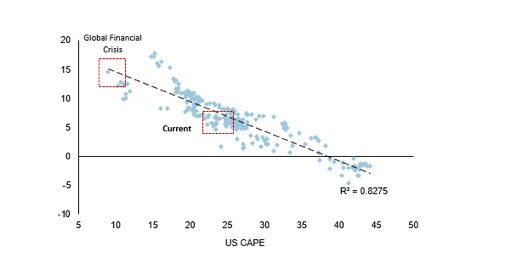
Source: FTSE Russell / Refinitiv. Data as of July 15, 2020. Past performance is no guarantee of future results. Please see the end for important legal disclosures.
Photo Credit: herval via Flickr Creative Commons
© 2020 London Stock Exchange Group plc and its applicable group undertakings (the “LSE Group”). The LSE Group includes (1) FTSE International Limited (“FTSE”), (2) Frank Russell Company (“Russell”), (3) FTSE Global Debt Capital Markets Inc. and FTSE Global Debt Capital Markets Limited (together, “FTSE Canada”), (4) MTSNext Limited (“MTSNext”), (5) Mergent, Inc. (“Mergent”), (6) FTSE Fixed Income LLC (“FTSE FI”), (7) The Yield Book Inc (“YB”) and (8) Beyond Ratings S.A.S. (“BR”). All rights reserved.
FTSE Russell® is a trading name of FTSE, Russell, FTSE Canada, MTSNext, Mergent, FTSE FI, YB and BR. “FTSE®”, “Russell®”, “FTSE Russell®”, “MTS®”, “FTSE4Good®”, “ICB®”, “Mergent®”, “The Yield Book®”, “Beyond Ratings®” and all other trademarks and service marks used herein (whether registered or unregistered) are trademarks and/or service marks owned or licensed by the applicable member of the LSE Group or their respective licensors and are owned, or used under licence, by FTSE, Russell, MTSNext, FTSE Canada, Mergent, FTSE FI, YB or BR. FTSE International Limited is authorised and regulated by the Financial Conduct Authority as a benchmark administrator.
All information is provided for information purposes only. All information and data contained in this publication is obtained by the LSE Group, from sources believed by it to be accurate and reliable. Because of the possibility of human and mechanical error as well as other factors, however, such information and data is provided “as is” without warranty of any kind. No member of the LSE Group nor their respective directors, officers, employees, partners or licensors make any claim, prediction, warranty or representation whatsoever, expressly or impliedly, either as to the accuracy, timeliness, completeness, merchantability of any information or of results to be obtained from the use of FTSE Russell products, including but not limited to indexes, data and analytics, or the fitness or suitability of the FTSE Russell products for any particular purpose to which they might be put. Any representation of historical data accessible through FTSE Russell products is provided for information purposes only and is not a reliable indicator of future performance.
No responsibility or liability can be accepted by any member of the LSE Group nor their respective directors, officers, employees, partners or licensors for (a) any loss or damage in whole or in part caused by, resulting from, or relating to any error (negligent or otherwise) or other circumstance involved in procuring, collecting, compiling, interpreting, analysing, editing, transcribing, transmitting, communicating or delivering any such information or data or from use of this document or links to this document or (b) any direct, indirect, special, consequential or incidental damages whatsoever, even if any member of the LSE Group is advised in advance of the possibility of such damages, resulting from the use of, or inability to use, such information.
No member of the LSE Group nor their respective directors, officers, employees, partners or licensors provide investment advice and nothing contained in this document or accessible through FTSE Russell Indexes, including statistical data and industry reports, should be taken as constituting financial or investment advice or a financial promotion.
Past performance is no guarantee of future results. Charts and graphs are provided for illustrative purposes only. Index returns shown may not represent the results of the actual trading of investable assets. Certain returns shown may reflect back-tested performance. All performance presented prior to the index inception date is back-tested performance. Back-tested performance is not actual performance, but is hypothetical. The back-test calculations are based on the same methodology that was in effect when the index was officially launched. However, back- tested data may reflect the application of the index methodology with the benefit of hindsight, and the historic calculations of an index may change from month to month based on revisions to the underlying economic data used in the calculation of the index.
This publication may contain forward-looking assessments. These are based upon a number of assumptions concerning future conditions that ultimately may prove to be inaccurate. Such forward-looking assessments are subject to risks and uncertainties and may be affected by various factors that may cause actual results to differ materially. No member of the LSE Group nor their licensors assume any duty to and do not undertake to update forward-looking assessments.
No part of this information may be reproduced, stored in a retrieval system or transmitted in any form or by any means, electronic, mechanical, photocopying, recording or otherwise, without prior written permission of the applicable member of the LSE Group. Use and distribution of the LSE Group data requires a licence from FTSE, Russell, FTSE Canada, MTSNext, Mergent, FTSE FI, YB and/or their respective licensors.



